Khapse: A sweet believed to bring peace and tranquility
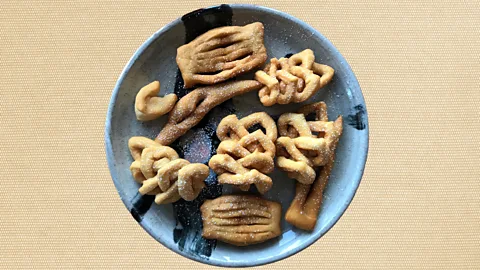 Ridhi Agrawal
Ridhi AgrawalThis ancient snack is synonymous with Tibetan New Year and will soon be prepared by millions of families.
At the entrance of the Kemgun Gumba monastery in Lukla, Nepal, an indigo-blue sign reads "dining". Inside, nearly a dozen women and a few men are hard at work, hunched over long tables, deftly mixing, rolling and slicing dough into thin rectangular strips. Each strip is slit in the middle, and one side of the dough is pulled into a ribbon-like bow. The rhythmic pounding of dough punctuates the crackle of oil sizzling in a large vessel outside, as boys and girls transform the doughy strips into deep-fried khapse (kha zas in Tibetan), a sweet, crunchy snack central to Tibetan and Sherpa Buddhists.
"Kha means 'mouth', and sey means 'snack'," said chef Yeshi Jampa, co-author of the book Taste Tibet and founder of the eponymous Taste Tibet restaurant in Oxford. "It's a symbol of [Tibetan] New Year," or Losar, he added.
Every year, millions of Tibetan and Sherpa Buddhists in Tibet, Nepal, Bhutan, India and elsewhere celebrate Losar (lo means "year" and gsar means "new"). The 15-day festival (which starts 28 February 2025) occurs on the first day of the Tibetan Lunar calendar and celebrates renewal and new beginnings. The first three days of the festival are considered the most important when followers visit monasteries, offer ceremonial scarves, receive blessings from Rinpoches (respected Tibetan teachers or lamas) and prepare special dishes with friends and family – especially khapse.
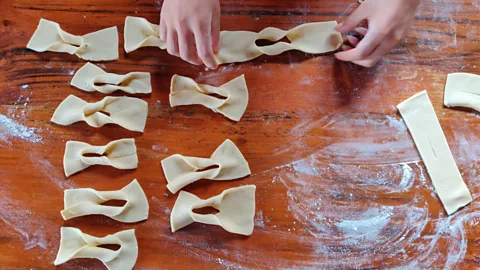 Ridhi Agrawal
Ridhi AgrawalEating khapse on Losar is thought to bring warmth, peace and tranquillity in the new year, and preparing it is both an art and a labour-intensive process. The dough (made of wheat flour, butter, sugar and oil with an optional egg) is kneaded, rolled and shaped into designs like flowers, knots and braids before being and fried in ghee (clarified butter).
According to Geshema Delek Dolma, a nun at Dolma Ling Nunnery in northern India's Himachal Pradesh state, the history of khapse is intertwined with early Bon rituals – the indigenous religion practised across the Tibetan plateau before the arrival of Buddhism in the 7th Century CE – where blood offerings were made to deities.
"[Instead] of animal sacrifice, the custom evolved into offering khapse, which was sometimes coloured red as a symbolic gesture," Dolma said. "The practice eventually spread to the other two provinces [Amdo and Kham] of Tibet."
Khapse-making is a communal activity.Itrequires many hands to prepare the honey-golden pastries in large quantities so it can be distributed to friends, family and across the community. So in the days ahead of Losar, family members come together to prepare large batches of khapse.
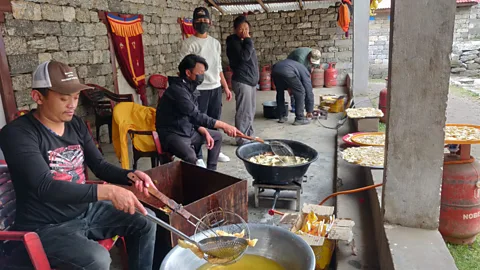 Ridhi Agrawal
Ridhi Agrawal"It depends on how much quantity [of khapse] you have to make," said Kanchhi Maya Sherpa, who runs the Hotel Sherwi Hyul in Kathmandu. "It's impossible for one [or] two people to make it as we need to knead the mixture together for a long time. Working together in the Gumba [monastery] is community work."
Followers first offer khapse to the deities as part of their religious practice, and afterwards, the crunchy treat is shared with others, including the poor, as a means of charity. "This is always the tradition because Tibetans believe in the service of others before self," said Jampa.
As Jamyang Norbu, author of the book Echoes From Forgotten Mountains, notes on his blog, the first piece of khapse isn't actually eaten or offered. Instead, it's customary to shape the dough in a scorpion-shaped cookie, fry it and then place it outside the kitchen until "the 15th day of the New Year to ward off bad luck and possible accidents that could take place during the [khapse]-making".
"Traditionally, it was believed that making khapse could predict success for the upcoming year," explained Dolma. For example, oil spilling during the frying process was considered a bad omen. Jampa recalled an accident from his childhood that ruined his family's New Year celebrations. "[It meant] evil," he said, noting how preparing the snack is steeped in cultural beliefs.
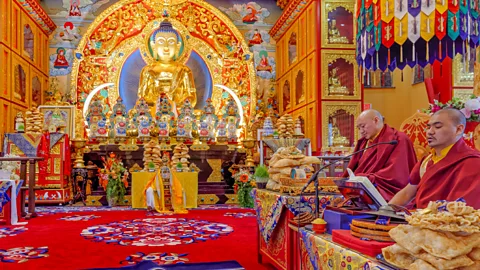 Alamy
AlamyKhapse recipes and the shapes the snack takes vary across regions and families. In Tibet's Markam County, where Jampa grew up, khapse was traditionally sweetened with organic honey from their beehives instead of sugar. Khapse made with honey "makes the biscuit a little softer", he explained. "The sweetness of honey-made khapse arrives more slowly." In contrast, recipes that call for sugar have a crunchier texture.
"Different parts of Tibet mould khapse differently [and] in different shapes," Jampa said. "I am from Kham. In my village, we make less ornate khapse, known as kong-chen – a narrow rectangular piece of dough with a cut in the middle through which one side of the khapse is pulled through." Another style, the hrug-hrug, "are basically just small rectangles or triangles of dough that require no further work", Jampa explained.
Khapse is also deeply connected to Buddhist rituals. During Losar, flowers, fruits, grains, nuts, salt, butter and water are placed on the altar, as offerings to deities, alongside stacks of khapse arranged in towers called derga.
"Derga khapses are different shapes, compared to the khapses that we eat," my Tibetan friend, Tenzin Diki, told me. "We add khapse in the shape of a crescent moon and a sun on the derga. We also add beautiful kharu (smaller, ornately designed pieces of khapse) on the derga, and decorate it with chhurpi [traditional cheese], sweets [and] rock sugar."
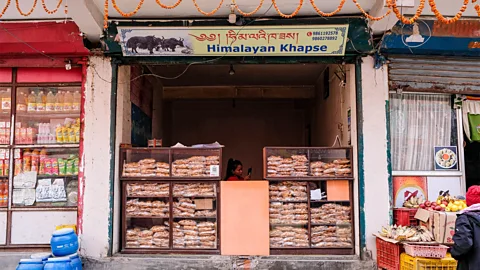 Ridhi Agrawal
Ridhi AgrawalToday, these fried cookies have evolved in style and shape and are eaten throughout the year. Khapse is sold year-round at stores in Kathmandu and many families prepare it as a snack outside of Losar. A quick online search for "khapse" or "khapsey" shows legions of home chefs and food bloggers experimenting with moulding the cookies and preparing them with additional ingredients like banana, beetroot, spinach and more.
"These days, people have modernised khapse, using their creativity, adding motifs to shape it differently," Sherpa explained. "The shapes now depend on how much creativity one has. You can make it in any shape you want."
Yet, not everyone embraces these innovations. "We have to keep traditional things traditional," said Jampa. "[Khapse] is a special ceremony snack, a symbol of family effort and [it] reminds us that it is something special."
--
If you liked this story, sign up for The Essential List newsletter – a handpicked selection of features, videos and can't-miss news, delivered to your inbox twice a week.
